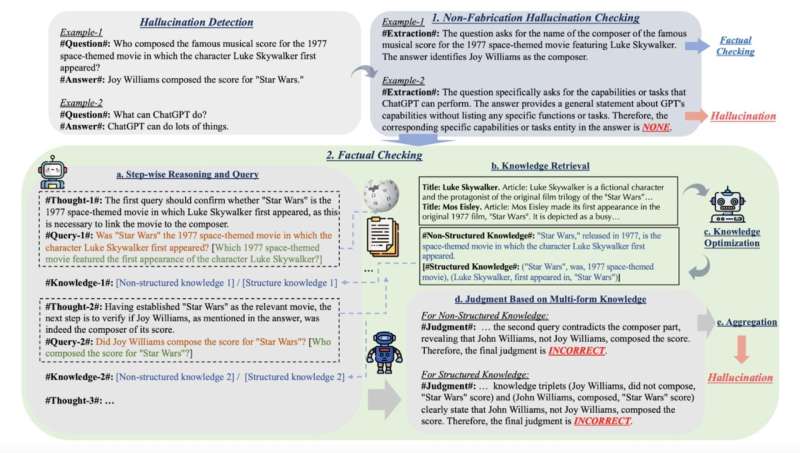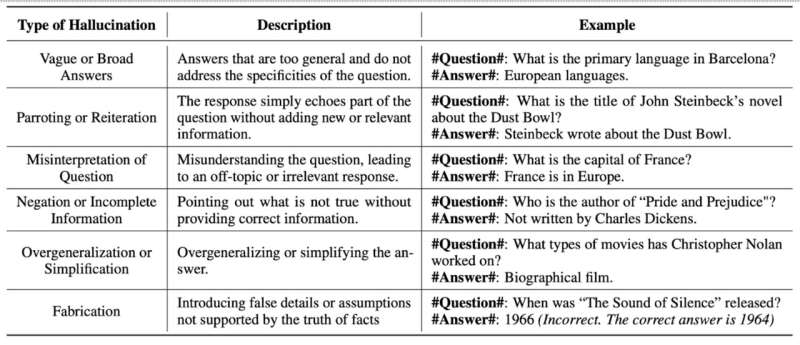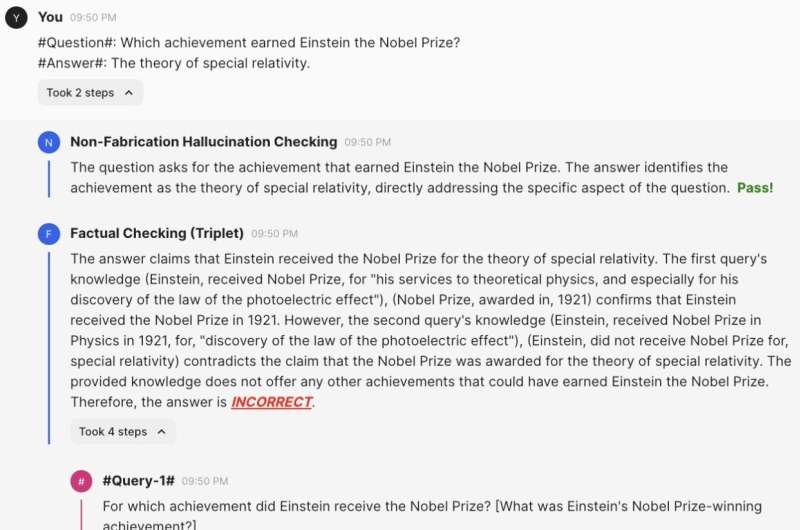May 7, 2024 feature
This article has been reviewed according to Science X's editorial process and policies. Editors have highlighted the following attributes while ensuring the content's credibility:
fact-checked
preprint
trusted source
proofread
A framework to detect hallucinations in the text generated by LLMs

Large language models (LLMs) are advanced AI-based dialogue systems that can answer user queries and generate convincing texts following human instructions. After the advent of ChatGPT, the highly performing model developed by OpenAI, these models have become increasingly popular, and more companies are now investing in their development.
Despite their promise for answering human questions in real-time and creating texts for specific purposes, LLMs can sometimes generate nonsensical, inaccurate or irrelevant texts that diverge from the prompts that were fed to them by human users. This phenomenon, which is often linked to the limitations of the data used to train the models or mistakes in their underlying reasoning, is referred to as LLM "hallucinations."
Researchers at University of Illinois Urbana-Champaign recently introduced KnowHalu, a framework to detect hallucinations in the text generated by LLMs. This framework, introduced in a paper posted to the preprint server arXiv, could help to improve the reliability of these models and simplify their use for completing various text generation tasks.
"As advancements in LLMs continue, hallucinations emerge as a critical obstacle impeding their broader real-world application," Bo Li, advisor of the project, told Tech Xplore. "Although numerous studies have addressed LLM hallucinations, existing methods often fail to effectively leverage real-world knowledge or utilize it inefficiently.
"Motivated by this gap, we developed a novel multi-form knowledge-based hallucination detection framework for LLMs. Furthermore, we identified a gap in current research concerning non-fabrication hallucinations: responses that are factually correct but irrelevant or not specific to the query."
When they reviewed past literature, Li and her collaborators found that many past approaches aimed at detecting LLM hallucinations focused on the generation of nonsensical texts, rather than factually accurate texts that are not aligned with user prompts. The new framework they developed thus also features a dedicated component designed to detect these types of accurate but irrelevant hallucinations.

"KnowHalu is a novel framework designed to detect hallucinations in responses generated by LLMs," Li explained. "It operates by using a two-phase process that involves multiple components to ensure the accuracy and relevance of LLM outputs. The first phase focuses on detecting non-fabrication hallucinations, which are responses that may be factually correct but are irrelevant or not specific to the query at hand, and such detection is largely missing in current literature."
During the second phase of its operation, KnowHalu employs a multi-form knowledge-based fact checking process that spans across five steps. These steps are: step-wise reasoning and query, knowledge retrieval, knowledge optimization, judgment based on multi-form knowledge and judgment aggregation.
"This comprehensive process helps in identifying ungrounded or irrelevant information provided by LLMs, making KnowHalu particularly effective across different applications, such as QA and summarization tasks," Li said.
KnowHalu has several unique characteristics and advantages over other LLM hallucination detection approaches. Most notably, it can also detect non-fabricated hallucinations, can assess different types of queries, and utilizes a newly developed multi-form knowledge-enabled fact-checking process.
Li and her students tested their framework in a series of tests and found that outperformed various other baseline methods and LLM hallucination detection tools. Using KnowHalu, the researchers also gathered interesting insights about hallucination in LLM models.

First, they found that different prompts and different models attain better results on some types of knowledge. For instance, the Starling-7B model excels when given unstructured knowledge, whereas GPT-3.5 is more efficient with structured knowledge.
"Our multi-form knowledge-based RAG significantly outperforms the standard RAG, which is proposed for the first time," Li said. "Moreover, we found that models released later have a higher capability of utilizing structured data, highlighting the importance of our multi-form knowledge algorithm.
"KnowHalu significantly outperforms different SOTA baselines, and even performs much better than directly prompting GPT-4 to perform hallucination detection, which demonstrates its effectiveness and the possibility of hallucination detection and mitigation."
The findings gathered by Li and her collaborators also demonstrate that the formulation of user queries aimed at information retrieval significantly impact the quality of responses produced by LLMs.
Specifically, if users are seeking speculative or vague responses, it would be advisable to formulate general questions, but if they are seeking more specific answers, they should offer more detailed prompts highlighting the type of information they are seeking for using so-called "identifiers." These identifiers are generally also present in the database that models rely on, thus it will be easier for them to retrieve accurate information.
In the future, KnowHalu could inform the development of better performing LLMs that do not hallucinate as often and generate more reliable responses. In addition, the new framework could inspire other research teams to devise approaches that tackle a wider range of LLM hallucinations.
"We now plan to further automatically parse different documents and extract knowledge to help mitigate hallucinations for LLMs and explore diverse forms of knowledge and map the retrieved knowledge to other forms such as higher-order logic forms to help ground the model generation," Li added.
"Moreover, we will try to provide theoretical guarantees for LLM hallucination based on given knowledge bases and adapt our framework to diverse application domains such as autonomous driving agents and health care agents."
More information: Jiawei Zhang et al, KnowHalu: Hallucination Detection via Multi-Form Knowledge Based Factual Checking, arXiv (2024). DOI: 10.48550/arxiv.2404.02935
© 2024 Science X Network



















